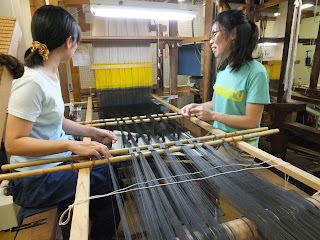(For non web dorks, that's a reference to the meme of the surprised owl asking "Oh, Really?" but misspelled because... it's funny. No, there is no better explanation. You either find it hilarious or you don't.)
The Japanese word "orimono" means "woven things" or "textiles," so "ori" as a suffix can be stuck on to a style of weaving. I wrote last year about saki-ori, or rag weaving. This summer, as part of our language/culture course with Genki JACS, we visited the Hakata-ori Development College to learn about a local specialty.
"Hakata" used to be a separate small city, the port beside Fukuoka Castle. Nowadays, there's just one city, called Fukuoka. But many of the cultural things carry the Hakata name - such as Hakata ramen and Hakata dolls - rather than Fukuoka. Hakata-ori, therefore, is a local loom-woven silk fabric which, in its most traditional form, looks like this: (note that this is the reverse side)
This is similar to many Southeast Asian designs, particularly Chinese minority designs and Vietnamese designs. I'd find you examples but I kind of have a headache and this post is taking forever, so just trust me on this. Anyway, it's because the original Hakata family of weavers traveled to China to study weaving, once in the 1200s and then again around 1500 for a refresher course. (Yes, these were two different people, not a clan of immortal vampire weavers. Which would also be awesome).
The design above contains Buddhist symbols in the center: the X/star pattern represents, I think, the monk's prayer wheel.
(Note the logo in the upper left - this appears on certified authentic handicraft products).
The stripes represent a family. The thicker stripes are parents, so the one set of stripes, with thick stripes on the outside, represents the parents protecting the children as the children grow up. When the stripes switch to thin on the outside, this symbolizes children caring for ageing parents. Buddhist prayer patterns and Confucian filial piety on an imported Chinese loom: it's like East Asian history in belt form!
Speaking of, the most common traditional use of Hakata-ori was as a belt, or obi, worn with a kimono. ("Obi" is a much-beloved Japanese word among crossword puzzle enthusiasts. It shows up constantly.) Our guide at the college said that obis are still popular, but due to cost, they sell a lot of smaller items as well. Coin purses are popular, as are men's neckties:

Back to symbolism. Each of the five traditional colors (yellow, indigo blue, red, green, and purple) has its own symbolic meaning. I have two different versions for this, although they're similar enough that there might just be a translation issue. The first source is my written notes from the college tour (of course I took written notes; I'm a history teacher. I also use semicolons in blog posts. If I started Tweeting, I'd use up all my characters on citations). The second source is an article on Hakata-ori from Fukuoka Now, the English-language local magazine.
This posterboard shows the characters and plant dyes used for each of the five traditional colors.

What's with the double names? The guide told us the fourth fabric sample in the picture was light blue, but it looks pretty darn green to me. I've been informed that in Japan, and Korea as well, people don't distinguish as sharply between the colors "blue" and "green." As a child who grew up with Buddy Blue and Patty O'Green from the Japanese show Rainbow Brite, I'm skeptical of this assertion, but I don't make these things up, I just report them. My friend Leslie, who spent a lot of time in Russia, says that Russians have entirely different words for "sky blue" and "dark blue." I consider this a strong warning about the dangers of communism.
Official, certified Hakata-ori carries the seal of the Japan Traditional Craft Center, which has identified 198 handicrafts made throughout Japan as worthy of preservation and authentication to the consumer market. (You can see the logo in the Buddhist prayer wheel picture above). Hakata-ori is hella expensive, which I didn't really understand until I saw it being manufactured at the college. As required by the JTCC, every step of the process is done by hand. They spin and dye their own silk, although not on the weaving site. This makes sense to me - as a teacher who survived a first grade art class, I advise that you never let anything wet or smelly near your final product, which is why I always locked the children out of the room for the entire class. You can't be too careful.
Hakata-ori is made on huge looms, and I can't even begin to understand how they work. These machines are so complex I can't believe that they were ever invented in the first place. Some key concepts: the fabric produced is the reverse side, so the weavers have to check the mirror to make sure the original pattern is correct; the long threads (warp) flip top and bottom, and the figure pattern is created via threading yarn through a card or computer program. I have no idea how, but I suspect witchcraft.
If you didn't think that was laborious enough, take a look at these ladies. The silk warp threads are not long enough for the intended final product (fabric to be cut into neckties), so what do they do?

These are students at the college, which is a two year program. They study, in addition to all the steps of weaving from silk production to putting on the obi, traditional Japanese arts like tea ceremony and flower arranging. The guide said it helped inform their production of the fabric, especially when it came to designing their own original patterns. Most students go on to work in the handicrafts industry, sometimes opening their own shops.







